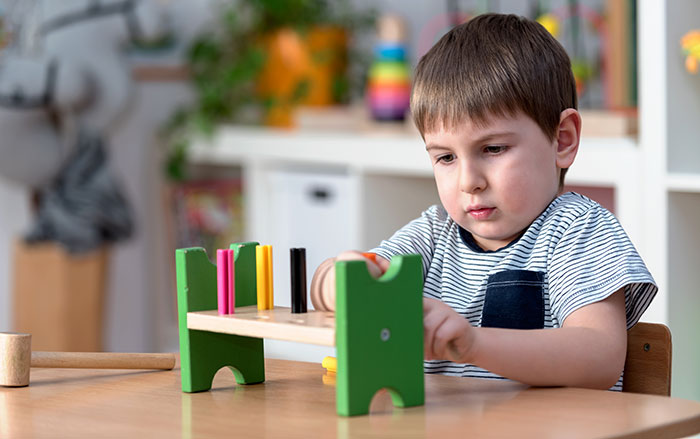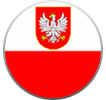On this page:
- List of schools
- What is Montessori?
- Characteristics of Montessori schools
- Benefits of Montessori education
- Quick summary of the Montessori method

What is Montessori?
According to the creator of this method, Dr. Maria Montessori, an Italian psychologist who studied early childhood development, children learn best when in close interaction with others and their surrounding environment. They are eager to watch other children, to learn from them, and often achieve a greater success in an environment of mentorship and shared learning, than in a traditional classroom. Montessori believed that the task of an educational institution is to create conditions for students to develop naturally, in a stress-free setting, gaining specific skills and knowledge at a pace that is right for them. Montessori schools and preschools in Poland adopt orthodox method to varying degrees.
A Montessori environment is unique. Unlike traditionally organized classrooms—with desks in rows facing the teacher at the front of the class—Montessori classrooms have designated work spaces, with teachers in a mentoring role, following the children, directing them, and helping them when needed. This classroom setting and student-teacher relationship is based on the conviction that the best support that children learn best when they have the freedom to make choices about the what they study, how their time is spent, and the activities are conducted. The Montessori approach allows children to be responsible for their learning, to have opportunities to check their progress, and to experience disappointment as well as the satisfaction that derives from their successes.
In the Montessori method, children are not left alone but followed by a teacher whose role is to help them discover their individual passions and develop their personal interests. Children are aware that they can always count on support from their peers and student mentors. In a majority of Montessori schools throughout Poland, classrooms are multi-aged: there is no division between classes corresponding to the date of birth of a child as in a traditional school. Maria Montessori believed that, in multi-aged environments, children are more motivated and move through the curriculum more quickly and efficiently.
In Montessori classrooms, children typically work alone or in small groups. At the same time they can choose the learning task, satisfying their own interests and developing their skills. This does not mean that there is chaos in the classes, and every student is doing what he likes. On the contrary, classes are quiet. Instructional time and rest time are strictly defined. Students move smoothly from one task to another, each at their own pace, quickly reaching high levels of knowledge in areas that are of interest to them. Likewise, they can devote as much time as they need to any specific task in order to master it. Children have the right to choose the subject according to their current level of knowledge, skills and interest.
That said, there are limitations in place in order to ensure that children gain proficiency with the core curriculum.
The organization of the Montessori approach is as follows:
- level I - kindergarten covering children aged 3 to 6
- level II - primary school with children from 6 to 9 years and
- level III - primary school with children aged 9 to 12 years.
Such age selection facilitates the individualization of the learning process, motivates younger children to learn, and increases instructional efficiency.
Poland's educational realities slightly modify this model. Elsewhere, there are variations in the year span assigned to the Montessori levels, both in terms of age and the number of years spent in a single level. Generally, it is a three-year level system: kindergarten (3-5 years) and grades I-III and IV-VI. Most Polish Montessori schools also provide day nurseries (from 1.5 years to 2.5 years) and some of them are junior high schools and even high schools (these are currently few in the country).
The vast majority of Montessori schools in Poland are private institutions operating under the laws of public schools, although there are also public schools that use the Montessori method. This include schools in Warsaw, Kraków, Poznań, Wrocław, Łódź, Gdańsk, Szczecin, Bydgoszcz, Lublin, and Rzeszów. This means that it is impossible to completely abandon the traditional system of assessing student achievement at the end of the year, provided in the form of a certificate of assessment and promotion from grade to grade. Montessori schools, both private and non-public, operate within overall education system and must fully implement the core curriculum established by the Ministry of National Education. Consequently, at the end of each school year, the students must obtain certificates, corresponding to their public school level regardless of the Montessori classroom divisions. Parallel, however, children receive descriptive assessments consistent with Montessori philosophy.
Students are not motivated by the traditional reward and punishment system, nor is there room for competition. Children learn in a friendly and compassionate atmosphere where they are co-creators and co-organizers of their learning.
In Montessori classrooms there is an understandable and unchanging sense of organization. All items have a permanent place, allowing children to internalize the geography of the classroom, and to trust their surroundings and work with them. Consistent teaching materials (so-called development aids) are selected to provide a transition from simple material to more difficult and abstract concepts, creating curiosity and triggering various forms of interaction with others. According to Maria Montessori classes should also include authentic washbasins, refrigerators, stoves, cleaning utensils, and even gardening tools. There is deliberately one of each, providing a necessity for children to share and, in turn, to be patient and respectful of others.
The above rules also apply to preschool classrooms, which in Poland are the most numerous. Of course, in preschool settings, assessment is not required to reflect national norms.

Characteristics of Montessori schools
- Self-direction: teachers support students only when necessary and in accordance with the principle of "help me do it myself";
- Individual, student-paced instruction: each child is working independently, using the classroom teaching aids;
- Teachers as mentors: teachers prepare the classroom environment and supports the efforts of the students within it;
- Freedom of movement: classrooms are not organized in the traditional way; children are free to chooses where they want to work, and the activities the want to engage within;
- Project-based instruction: children are free to take the time they need in order to master a task or concept;
- Emphasis on specific learning: the student acquires the skill by exploring a topic of particular interest;
- Curiosity-based learning: children choose activities, and work at their own pace;
- Multi-age classrooms: each classroom includes children of different ages, this to motivate learning, encourage peer mentorship, and develop social competence;
- Self-directed learning: the teacher creates a working atmosphere, offering a variety of themes and ways of acting. Children watch older students and are inspired by their actions;
- Cross-curricular instruction: the content of education is linked and interrelated;
- Student-paced learning: students are free to work at their own pace;
- Descriptive assessment: grades are not shown to students. The rating is descriptive and is prepared several times a year. In Poland, pupils also receive school certificates with grades, as required by the Ministry of Education. Children do not compete with each other—there is an atmosphere of friendship and cooperation in the classroom;
- No annual grade promotion: according to Montessori theory, each level of education lasts three years, after which the child goes to a higher level. It is possible to change the level faster, or to stay in a level longer. In Polish schools this is implemented in consort with educational regulations, which means that a child who has not received a grade IV to V promotion does not change the Montessori class and continues to study with the same children.
Benefits of Montessori education
Academic
Talent:
Children learn early on that following their interests and their personal sense of curiosity can lead to positive attitudes toward learning and high levels of academic achievement.
Flexible learning:
The learning process is flexible. This means that interested students can move faster within the program, face challenges, and get involved in their performance. Students who need more time can take it without the fear of criticism.
Practical learning:
Focusing on practical training, especially in the lower classes, leads to more effective learning. It enhances the discipline of work, concentration, and involvement of the student in the learning process.
Peer mentorship:
Older students teach and support the younger, fostering learning more quickly and effectively.
Increased Concentration:
Research in neuroscience (Lillard, 2005) confirms Maria Montessori's observation that uninterrupted periods of work can increase the child's attention, concentration and work discipline. This can be veru useful in the future.
A love of learning:
Children have a great deal of freedom in choosing the topic of work and the way in which it is implemented. In most cases it leads to constructive learning habits, in the classroom and beyond.
Social
Social skills:
Classroom structure and teacher guidance allow pupils to develop key social skills. They include communication, respect, cooperation, and exchange of knowledge and experience. Such skills are modeled and reinforced by the teacher and older children in the classroom.
Independence and personal responsibility:
Students learn from the beginning of their education to take care of their classrooms, their school, and their environment. They acquire practical skills such as cooking, cleaning, and gardening. This implies their independence, independence, and environmental stewardship.
Moral education:
Students are learn both from the teacher (lessons and directions) and peers (interaction and modeling). Friendships and interpersonal relationships based are strengthened. Children learn to respect others, and gain a sense of stewardship in within the community.
Quick summary of the Montessori method
Montessori schools in Poland are a unique alternative to traditional schools and kindergartens. The progressive approach to children's education, introduced by Dr. Maria Montessori, is used in thousands of schools around the world.
Montessori schools focus on the child. They do not have a pre-planned and specific curriculum. They are flexible and up-to-date, adapted to the needs and interests of children in all areas of education. In Poland, they also deliver the curriculum as set by the Ministry of National Education.
Montessori teachers work to develop a child’s natural desire to learn. By following children, directing and supporting them, allows them to develop freely, which results in increased confidence in their abilities and self-esteem.
Instruction is cross curricular. Teachers rarely lecture and children do a lot of self-directed work, mostly at their own pace. Working individually or in small groups, they often perform tasks that interest them and stimulate them.
In the early years, the Montessori method is based in concrete and practical teaching methods. In the higher classes, the use of abstract thinking becomes dominant.
Classroom organization differs from the traditional instructional organization. Traditional schools are characterized by a distinct distance separating the teacher from the student, with large classes and fewer specialized classes. This is not the case in a Montessori school: the teacher is a mentor who works according to the "help me do it myself" principle; classes are less numerous, and specialized instruction is undertaken based on the expressed interests of the children.
Montessori education is challenging, promotes independence, concentration and discipline. Its tailor-made approach to learning is optimal for many students, especially those who are highly motivated, who like to work independently, and prone to set goals for themselves.
People who read this also viewed:
- Montessori preschools
- Montessori schools in Warsaw
- Montessori nursery schools
- Our Kids Interview: Get to know English Montessori School Katowice
-
Advice Guide
- ABC of educational terminology: Glossary of terms and concepts
- The admissions process
- Advantages and disadvantages of studying in an international school
- The application process
- Benefits of Polish private schools
- Bilingual schools
- Boarding schools
- Choosing a private or nonpublic school in Poland
- Compare schools in Poland
- English schools in Warsaw
- Homeschooling
- International schools in Kraków
- International schools
- Private school interviews
- Music education
- Myths about private education
- Non-public schools in Poland
- School open houses
- Our Kids Interview: Get to know EF Academy Oxford
- Our Kids Interview: Get to know Open School
- Our Kids interview: Get to know Regent College International Schools
- Our Kids Interview: Get to know The American School of Warsaw
- Our Kids Interview: Get to know The British School Warsaw
- Our Kids Interview: Get to know Wrocław Cosmopolitan School (two interviews, new video)
- Poland school profiles
- Private day schools
- Gifted schools & programs
- Private Jewish schools in Poland
- Language schools
- Private school tuition and costs in Poland
- Private schools in Poland
- Private schools in Poland offering French-language immersion
- English immersion schools
- Poland school uniforms
- Private special needs schools in Warsaw
- Public versus non-public schools in Poland
- Private school questions
- Private school rankings
- Reasons for choosing private schools - Our Kids’s survey report
- Religious schools
- Schools and classes for children with ADHD in Poland
- Social primary schools
- Social Schools
- Special educational needs (SPE) certificates
- Special needs schools
- Study abroad at a private school
- The first annual non-public school fair in Poland
- The first annual Our Kids non-public school expo in Warsaw was a great success
- Third Private School Expo in Warsaw - summary
- Types of schools
- Types of schools in Warsaw
- Warsaw preschool costs
- Why private school?
- Why parents go private
-
Grades
- Boarding high schools
- Choosing a high school in Poland
- Mokotow High School Campus - a new Warsaw high school and Thames British School campus
- Montessori nursery schools
- Montessori preschools
- Our Kids Interview: Get to know English Montessori School Katowice
- Our Kids Interview: Get to know FSA School
- Our Kids Interview: Get to know KIDS & Co.
- Our Kids Interview: Get to know Polish British Academy of Warsaw
- Our Kids Interview: Get to know The English Playhouse and The English Primary
- Poland education: grade levels
- Preschools in Warsaw
- Private & non-public preschools
- Private & non-public primary schools
- Private bilingual elementary schools in Warsaw
- Private high schools
- Private high schools in Warsaw
- Private middle schools
- Nursery schools
- Private primary schools in Warsaw
- Social high schools
-
Locations
- Boarding schools in Warsaw
- English schools in Kraków
- International Baccalaureate (IB) schools in Warsaw
- International schools in Warsaw
- Montessori schools in Warsaw
- Non-public schools in Warsaw
- Our Kids Interview: Get to know EF Academy
- Our Kids interview: Get to know Excellence in Education better
- Our Kids Interview: Get to know PRIMUS Non-Public Primary School No. 47 and Non-Public Secondary School
- Our Kids Interview: Get to know the Canadian School of Warsaw
- Our Kids Interview: Get to know The Primary and Secondary Schools of the Sisters of Nazareth in Warsaw
- Private Catholic and Christian schools in Warsaw
- Private day schools in Warsaw
- Private language schools in Warsaw
- Private schools in Bialystok
- Bydgoszcz schools
- Częstochowa schools
- Private schools in Gdańsk & Gdynia
- Katowice schools
- Private schools in Krakow
- Lublin schools
- Olsztyn schools
- Private schools in Poznań
- Private schools in Rzeszów
- Szczecin schools
- Private schools Warsaw
- Private schools in Wrocław
- Zielona Góra schools
- Private schools in Łódź










 POL
POL CAN
CAN